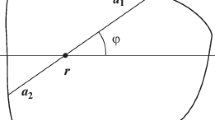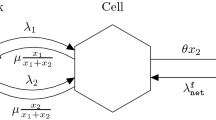Abstract
Traffic analysis for third generation mobile telecommunication systems should take into account a variety of services (e.g., voice, data, video) and “environments” (private, public outdoor, public indoor) as well as the user mobility behavior. The analytical traffic model presented in this paper incorporates all the above mentioned features. The model utilizes a set of simplifying assumptions regarding the distribution of certain random time intervals (e.g., call duration and “cell residence time”) and the handover arrival process. The core of the model focuses on the estimation of the cell border crossing rate and the time it takes a busy mobile user to leave a cell area. This allows for the estimation of the handover rate and the call duration within a cell, which in turn, utilizing an iterative method, allows for the calculation of the offered traffic load per cell. The major advantages of the model are: (a) the simple closed form solutions, (b) its independence from the applied radio resource management scheme, and (c) its accuracy. The latter is validated via a simulation tool, which accommodates different cell-layout scenarios over a geographical area, representing a ‘typical’ city center, modeled as a Manhattan grid.
Similar content being viewed by others
References
E. Alonso, K.S. Meier-Hellstern and G.P. Pollini, Influence of cell geometry on handover and registration rates in cellularand universal personal telecommunications networks, in: 8th ITC specialist Seminar on Universal Personal Telecommunication, Geneva (October 1992) pp. 261–270.
S. El-Dolil, W. Wong and R. Steele, Teletraffic performance of highway microcells with overlay macrocell,IEEE Journal on Selected Areas in Communications 7(1) (January 1989) 71–78.
P. Elliott and A. Majeed, The effects ofin-call mobility in a microcellular communications system, in: IEEE Intern. Conf. on Communications, ICC’ 93, Geneva (May 1993) pp. 1955–1959.
G. Foschini, B. Gopinath and Z. Miljanic, Channel cost of mobility, IEEE Transactions on Vehicular Technology42(4) (November 1993) 414–424.
M. Frullone, P. Grazioso and A.M. Serra, Performance evaluation of a personalcommunication system in a urban environment, in: 42nd IEEE Vehicular Technology Conf., Denver (May 1992) pp. 498–501.
D. Hong and S.S. Rappaport, Traffic model and performance analysis for cellular mobile radio telephone systems with prioritized andnonprioritized handoff procedures, IEEE Transactions on Vehicular Technology 35(3) (August 1986) 77–92.
W.M. Jolleyand R.E. Warfield, Modelling and analysis of layered cellular mobile networks, in: 13th International Teletraffic Congress, Copenhagen (June 1991) pp. 161–166.
G.L. Lyberopoulos, J.G. Markoulidakis and M.E. Anagnostou, The impact of evolutionary cell architectureson handover in future mobile telecommunication systems, in: Proceedings IEEE Vehicular Technology Conf.’ 94, Stockholm (June 1994) pp. 120–124.
G.C. Manos, M.E. Anagnostou, J.G. Markoulidakis and G.L. Lyberopoulos, Simulation models for handover performanceevaluation studies, in: 4th Intern. Conf. on Advances in Communications and Control, Telecommunications/Signal Processing: From Defence to Commerce, Rhodes, Greece (14–18 June 1993).
J.G. Markoulidakis, G.L. Lyberopoulos, D.F. Tsirkas and E.D. Sykas, Mobilitymodelling in third generation mobile telecommunication systems, IEEE Personal Communications 4(3) (August 1997) 41–56.
J.G. Markoulidakis and E.D. Sykas, Model for location updating and handover rate estimation in mobile telecommunications, IEEElectronics Letters 29(17) (August 1993) 1574–1575.
D. McMillan, Traffic modelling and analysis for cellular mobilenetworks, in: 13th International Teletraffic Congress, Copenhagen (June 1991) pp. 627–632.
W. Mende, On the hand-overrate in future cellular systems, in: IEEE Vehicular Technology Conf.’ 88, pp. 358–361.
N. Mitrou, G. Lyberopoulos and A. Panagopoulou, Voice and data integration in the air interface of a microcellular mobile communication system, IEEE Transactions on Vehicular Technology 42(1) (February 1993) 1–13.
G. Montenegro, M. Sengoku, Y. Yamaguchi and T. Abe, Timedependent analysis of mobile communication traffic in a ring-shaped service area with non-uniform vehicle distribution, IEEE Transactions on Vehicular Technology 41(3) (August 1992) 243–254.
G. Morales-Andres and M. Villen-Altamirano, An approach tomodelling subscribers mobility in cellular radio networks, in: Forum Telecom’ 87, Geneva (1987).
M. Mouly and M.-B. Pautet,The GSM System for Mobile Communications, published by the authors, Palaiseau, France (1992).
S. Nanda, Teletraffic models forurban and suburban microcells: Cell sizes and handoff rates, IEEE Transactions on Vehicular Technology 42(4) (November 1993) 673–682.
A. Ralstone, A First Course in Numerical Analysis (McGraw-Hill, 1965).
J. Rapeli, UMTS: Targets, systemconcept, and standardisation in a global framework, IEEE Personal Communications (February 1995) 20–28.
S.S. Rappaport,The multiple-call hand-off problem in high-capacity cellular communications systems, IEEE Transactions on Vehicular Technology 40(3) (August 1991) 546–577.
P.A. Raymond, Performance analysis of cellular networks, IEEE Transactions on Communications39(12) (December 1991) 1787–1793.
S. Sato, K. Takeo, M. Nishino, Y. Amezawa and T. Suzuki, A performanceanalysis on non-uniform traffic in microcell systems, in: IEEE Intern. Conf. on Communications, ICC’ 93, Geneva (May 1993) pp. 1960–1964.
C. Yoon and C. Un, Performance of personal portable radio telephone systems with and without guard channels, in: IEEE Intern.Conf. on Communications, ICC’ 93, Geneva (May 1993) pp. 1947–1951.
T. Yum and W. Wong, Hot-spot relief in cellularsystems, IEEE Journal on Selected Areas in Communications 11(6) (August 1993) 934–940.
Author information
Authors and Affiliations
Rights and permissions
About this article
Cite this article
Markoulidakis, J., Lyberopoulos, G. & Anagnostou, M. Traffic model for third generation cellular mobile telecommunication systems. Wireless Networks 4, 389–400 (1998). https://doi.org/10.1023/A:1019181028954
Issue Date:
DOI: https://doi.org/10.1023/A:1019181028954




